COVID-19 Pandemic Lockdown and Religious Mediatization of Social Sustainability. A Case Study of Romania
Abstract
1. Introduction
2. Theoretical Background
3. Methodology
- (1)
- The denominational otherness of the selected media production.
- (2)
- The quantitative gap between the indicators of social sustainability in the selected media production.
- (3)
- The media balance between the two conceptual levels of social sustainability—physical well-being and quality of life/equity.
- (4)
- The denominational disparity in the treatment of the two conceptual levels of social sustainability—physical well-being and quality of life/equity.
- (5)
- The denominational specificity in the treatment of social sustainability.
- (6)
- The accentuated and concordant intensity of the mediatization of certain indicators of social sustainability.
4. Results
4.1. The Denominational Otherness of the Selected Media Production
4.2. The Quantitative Gap between the Indicators of Social Sustainability in the Selected Media Production
4.3. The Media Balance between the Two Conceptual Levels of Social Sustainability—Physical Well-Being and Quality of Life/Equity
4.4. The Denominational Disparity in the Treatment of the Two Conceptual Levels of Social Sustainability—Physical Well-Being and Quality of Life/Equity
4.5. The Denominational Specificity in the Treatment of Social Sustainability
4.6. The Accentuated and Concordant Intensity of the Mediatization of Certain Indicators of Social Sustainability
5. Discussion
6. Conclusions
Author Contributions
Funding
Institutional Review Board Statement
Informed Consent Statement
Conflicts of Interest
References
- Oxford Institute for Sustainable Development (OISD) and European Investment Bank (EIB). Measuring Socially Sustainable Urban Regeneration in Europe; Oxford Brookes University: Oxford, UK, 2009. [Google Scholar]
- Tudor, M.A.; Bratosin, S. The Romanian Religious Media Landscape: Between Secularization and the Revitalization of Religion. J. Relig. Media Digit. Cult. 2018, 7, 223–250. [Google Scholar] [CrossRef]
- Bratosin, S.; Tudor, M.A. Church, Religion and Belief: Paradigms for understanding the political phenomenon in post-communist Romania. J. Study Relig. Ideol. 2009, 8, 3–17. [Google Scholar]
- European Commission. Special Eurobarometer. 2010. Available online: https://ec.europa.eu/commfrontoffice/publicopinion/archives/ebs/ebs_341_en.pdf (accessed on 12 August 2020).
- Gabor, A.; Muresan, R.P. Biserica Ortodoxa in Uniunea Europeana. Contribuţii necesare la securitatea şi stabilitatea europeana; Editura Universitatii din Bucuresti: Bucuresti, Romania, 2006. [Google Scholar]
- Tanase, L. Pluralisation Religieuse et Société en Roumanie; Peter Lang: Bern, Switzerland, 2008. [Google Scholar]
- Shafir, M. From Historical to “Dialectical” Populism: The Case of Post-Communist Romania. Canadian Slavonic Papers/Revue Canadienne des Slavistes 2008, 50, 425–470. [Google Scholar] [CrossRef]
- Aalberg, T. Populist Political Communication in Europe; Routledge: New York, NY, USA, 2016. [Google Scholar]
- Huntington, S. Le Choc des Civilisations; Odile Jacob: Paris, France, 1997; p. 164. [Google Scholar]
- Habermas, J.; Lennox, S.; Lennox, F. The public sphere: An encyclopedia article (1964). New Ger. Crit. 1974, 3, 49–55. [Google Scholar] [CrossRef]
- Garnham, N. The media and the public sphere. In Inf. Soc. Read.; Routledge: London, UK, 1992; pp. 357–365. [Google Scholar]
- Meyer, B.; Moors, A. (Eds.) Religion, Media, and the Public Sphere; Indiana University Press: Bloomington, IN, USA, 2005. [Google Scholar]
- Fuchs, C. Social media and the public sphere. tripleC: Communication, Capitalism & Critique. Open Access J. Glob. Sustain. Inf. Soc. 2014, 12, 57–101. [Google Scholar]
- Mucchielli, A. Les Sciences de L’information et de la Communication; Hachette Education: Paris, France, 2006. [Google Scholar]
- Olivesi, S. Sciences de L’information et de la Communication: Objets, Savoirs, Discipline; PUG: Grenoble, France, 2014. [Google Scholar]
- Dacheux, É. Les Sciences de L’information et de la Communication; CNRS Éditions via OpenEdition: Paris, France, 2019. [Google Scholar]
- Checker, M. The Sustainability Myth: Environmental Gentrification and the Politics of Justice; NYU Press: New York, NY, USA, 2020. [Google Scholar]
- Cohen, M.J. Sustainability; Polity Press: Cambridge, UK, 2020. [Google Scholar]
- Gibbert, M.; Välikangas, L.; Luistro-Jonsson, M. The Sustainability Grand Challenge: A Wicked Learning Workbook; Routledge: London, UK, 2020. [Google Scholar]
- Jones, R.G. The Applied Psychology of Sustainability; Routledge: London, UK, 2020. [Google Scholar]
- Stanwick, P.A.; Stanwick, S.D. Corporate Sustainability Leadership; Routledge: London, UK, 2020. [Google Scholar]
- Wagner, S.M. Business and Environmental Sustainability: Foundations, Challenges and Corporate Functions; Routledge: London, UK, 2020. [Google Scholar]
- Wasieleski, D.M.; Weber, J. (Eds.) Sustainability; Emerald Group Publishing: Bingley, UK, 2020. [Google Scholar]
- Tracey, S.; Anne, B. OECD Insights Sustainable Development Linking Economy, Society, Environment: Linking Economy, Society, Environment; OECD Publishing: Paris, France, 2008. [Google Scholar]
- Hansmann, R.; Mieg, H.A.; Frischknecht, P. Principal sustainability components: Empirical analysis of synergies between the three pillars of sustainability. Int. J. Sustain. Dev. World Ecol. 2012, 19, 451–459. [Google Scholar] [CrossRef]
- Martine, G.; Alves, J.E.D. Economy, society and environment in the 21st century: Three pillars or trilemma of sustainability? Rev. Bras. De Estud. De Popul. 2015, 32, 433–460. [Google Scholar] [CrossRef]
- Asche, F.; Garlock, T.M.; Anderson, J.L.; Bush, S.R.; Smith, M.D.; Anderson, C.M.; Oglend, A. Three pillars of sustainability in fisheries. Proc. Natl. Acad. Sci. USA 2018, 115, 11221–11225. [Google Scholar] [CrossRef]
- Purvis, B.; Mao, Y.; Robinson, D. Three pillars of sustainability: In search of conceptual origins. Sustain. Sci. 2019, 14, 681–695. [Google Scholar] [CrossRef]
- Mitlin, D.; Satterthwaite, D. Chapter one sustainable development and cities. In Sustainability: The Environment and Urbanization; Routledge: London, UK, 1996; pp. 23–61. [Google Scholar]
- Basiago, A.D. Economic, social, and environmental sustainability in development theory and urban planning practice. Environmentalist 1998, 19, 145–161. [Google Scholar] [CrossRef]
- Nahapiet, J.; Ghoshal, S. Social capital, intellectual capital, and the organizational advantage. Acad. Manag. Rev. 1998, 23, 242–266. [Google Scholar] [CrossRef]
- Sachs, I. Social sustainability and whole development: Exploring the dimensions of sustainable development. In Sustainability and the Social Sciences: A Cross-Disciplinary Approach to Integrating Environmental Considerations into Theoretical Reorientation; Zed Books: London, UK, 1999; pp. 25–36. [Google Scholar]
- Polèse, M.; Stren, R.E.; Stren, R. (Eds.) The Social Sustainability of Cities: Diversity and the Management of Change; University of Toronto Press: Toronto, ON, Canada, 2000. [Google Scholar]
- Enyedi, G. Social Sustainability of Large Cities. Ekistics 2002, 69, 142–144. [Google Scholar]
- Chiu, R.L. Social equity in housing in the Hong Kong special administrative region: A social sustainability perspective. Sustain. Dev. 2002, 10, 155–162. [Google Scholar] [CrossRef]
- Chiu, R.L. Social Sustainability and Sustainable Housing. In Housing and Social Change: East-West Perspectives; Forrest, R., Lee, J., Eds.; Routledge: London, UK, 2003. [Google Scholar]
- Hobson, K. Thinking habits into action: The role of knowledge and process in questioning household consumption practices. Local Environ. 2003, 8, 95–112. [Google Scholar] [CrossRef]
- Strigl, A.W. Science, research, knowledge and capacity building. Environ. Dev. Sustain. 2003, 5, 255–273. [Google Scholar] [CrossRef]
- Bhatti, M.; Church, A. Home, the culture of nature and meanings of gardens in late modernity. Hous. Stud. 2004, 19, 37–51. [Google Scholar] [CrossRef]
- Godschalk, D.R. Land use planning challenges: Coping with conflicts in visions of sustainable development and livable communities. J. Am. Plan. Assoc. 2004, 70, 5–13. [Google Scholar] [CrossRef]
- Halme, M.; Jasch, C.; Scharp, M. Sustainable homeservices? Toward household services that enhance ecological, social and economic sustainability. Ecol. Econ. 2004, 51, 125–138. [Google Scholar] [CrossRef]
- Hargreaves, A. Building communities of place: Habitual movement around significant places. J. Hous. Built Environ. 2004, 19, 49–65. [Google Scholar] [CrossRef]
- Newell, S.; Tansley, C.; Huang, J. Social capital and knowledge integration in an ERP project team: The importance of bridging and bonding. Br. J. Manag. 2004, 15, 43–57. [Google Scholar] [CrossRef]
- Foladori, G. Advances and limits of social sustainability as an evolving concept. Can. J. Dev. Stud. Rev. Can. D’études Du Développement 2005, 26, 501–510. [Google Scholar] [CrossRef]
- Källström, H.N.; Ljung, M. Social sustainability and collaborative learning. Ambio: A J. Hum. Environ. 2005, 34, 376–382. [Google Scholar]
- Redclift, M. Sustainable development (1987–2005): An oxymoron comes of age. Sustain. Dev. 2005, 13, 212–227. [Google Scholar] [CrossRef]
- Crabtree, L. Sustainability begins at home? An ecological exploration of sub/urban Australian community-focused housing initiatives. Geoforum 2006, 37, 519–535. [Google Scholar] [CrossRef]
- Evans, B.; Joas, M.; Sundback, S.; Theobald, K. Governing local sustainability. J. Environ. Plan. Manag. 2006, 49, 849–867. [Google Scholar] [CrossRef]
- Colantonio, A. Social Sustainability: An Exploratory Analysis of Its Definition, Assessment Methods Metrics and Tools; EIBURS Working Paper Series (2007/01); Oxford Brooks University: Oxford, UK, 2007. [Google Scholar]
- Reed, M.G. Seeking red herrings in the wood: Tending the shared spaces of environmental and feminist geographies. Can. Geogr. Le Géographe Can. 2007, 51, 1–21. [Google Scholar] [CrossRef]
- Vlek, C.; Steg, L. Human Behavior and Environmental Sustainability: Problems, Driving Forces, and Research Topics. J. Soc. Issues 2007, 63, 1–19. [Google Scholar] [CrossRef]
- Budd, W.; Lovrich, N., Jr.; Pierce, J.C.; Chamberlain, B. Cultural sources of variations in US urban sustainability attributes. Cities 2008, 25, 257–267. [Google Scholar] [CrossRef]
- Bramley, G.; Power, S. Urban form and social sustainability: The role of density and housing type. Environ. Plan. B Plan. Des. 2009, 36, 30–48. [Google Scholar] [CrossRef]
- Vallance, S.; Perkins, H.C.; Dixon, J.E. What is social sustainability? A clarification of concepts. Geoforum 2011, 42, 342–348. [Google Scholar] [CrossRef]
- Murzyn-Kupisz, M. Cultural, economic and social sustainability of heritage tourism: Issues and challenges. Econ. Environ. Stud. 2012, 12, 113–133. [Google Scholar]
- Soini, K.; Birkeland, I. Exploring the scientific discourse on cultural sustainability. Geoforum 2014, 51, 213–223. [Google Scholar] [CrossRef]
- Riechers, M.; Barkmann, J.; Tscharntke, T. Perceptions of cultural ecosystem services from urban green. Ecosyst. Serv. 2016, 17, 33–39. [Google Scholar] [CrossRef]
- Awan, U.; Kraslawski, A.; Huiskonen, J. Governing interfirm relationships for social sustainability: The relationship between governance mechanisms, sustainable collaboration, and cultural intelligence. Sustainability 2018, 10, 4473. [Google Scholar] [CrossRef]
- Golicic, S.L.; Lenk, M.M.; Hazen, B.T. A global meaning of supply chain social sustainability. Prod. Plan. Control 2019, 28, 1–17. [Google Scholar] [CrossRef]
- Sadguna, I.G.A.J.; Komala, I.G.A.M.K.; Shishido, K. Balinese Art Studios: The Learning Process of Art and Culture to Support Sustainable Tourism. Int. J. Appl. Sci. Tour. Events 2020, 4, 68–73. [Google Scholar] [CrossRef]
- Gottlieb, R. You gonna be here long? Religion and Sustainability. Worldviews Glob. Relig. Cult. Ecol. 2008, 12, 163–178. [Google Scholar] [CrossRef]
- Johnston, L. The religious dimensions of sustainability: Institutional religions, civil society, and international politics since the turn of the twentieth century. Relig. Compass 2010, 4, 176–189. [Google Scholar] [CrossRef]
- Berry, E. Religion and sustainability in global civil society: Some basic findings from Rio+ 20. Worldviews Glob. Relig. Cult. Ecol. 2014, 18, 269–288. [Google Scholar] [CrossRef]
- Johnston, L.F. Religion and Sustainability: Social Movements and the Politics of the Environment; Routledge: London, UK, 2014. [Google Scholar]
- Cortese, F.; D’Ambrosio, I.; Petracca, M. A possible synergy between culture and religion for the sustainability of tourism of Pompeii. Sustainability 2019, 11, 2231. [Google Scholar] [CrossRef]
- Ives, C.D.; Kidwell, J. Religion and social values for sustainability. Sustain. Sci. 2019, 14, 1355–1362. [Google Scholar] [CrossRef]
- Retnaselvam, J.; Singh, P. Sustainability and the Sacred: A Comparative Study of Indian Religious Environmentalism with Special Reference to Christian and Indigenous Communities in the State of Kerala. Ph.D. Thesis, School of Divinity, The University of Edinburgh, Edinburgh, UK, 2019. [Google Scholar]
- Rimmer, C.; Philip, M.J. Sustainability and Religion. Consensus 2020, 41, 1. [Google Scholar]
- Thomas, L. (Ed.) Religion, Consumerism and Sustainability: Paradise Lost? Palgrave Macmillan: London, UK, 2010. [Google Scholar]
- Emerich, M.M. The Gospel of Sustainability: Media, Market and LOHAS; University of Illinois Press: Urbana, IL, USA, 2011. [Google Scholar]
- Lynch, G.; Mitchell, J.; Strhan, A. (Eds.) Religion, Media and Culture: A Reader; Routledge: London, UK, 2012. [Google Scholar]
- Miller, J.; Yu, D.S.; van der Veer, P. (Eds.) Religion and Ecological Sustainability in China; Routledge: London, UK, 2014. [Google Scholar]
- Tudor, M.A.; Bratosin, S. Croire en la technologie: Médiatisation du futur et futur de la médiatisation. Rev. Commun. 2020, 37, 11–16. [Google Scholar] [CrossRef]
- Lunt, P.; Livingstone, S. Is “mediatization” the new paradigm for our field? A commentary on Deacon and Stanyer (2014, 2015) and Hepp, Hjarvard and Lundby (2015). Media Cult. Soc. 2016, 38, 462–470. [Google Scholar] [CrossRef]
- Tudor, M.A.; Bratosin, S. La médiatisation. Nouveaux défis pour les sciences et la société; l’Harmattan: Paris, France, 2021; coll. Questions contemporaines – Questions de communication. [Google Scholar]
- Tudor, M.A.; Bratosin, S. French Media Representations towards Sustainability: Education and Information through Mythical-Religious References. Sustainability 2020, 12, 2095. [Google Scholar] [CrossRef]
- Lundby, K. Media logic: Looking for social interaction. In Mediatization: Concept, Changes, Consequences; Lundby, K., Ed.; Peter Lang: New York, NY, USA, 2003; pp. 191–202. [Google Scholar]
- Hepp, A. Differentiation: Mediatization and cultural change. In Mediatization: Concept, Changes, Consequences; Lundby, K., Ed.; Peter Lang: New York, NY, USA, 2009. [Google Scholar]
- Hjarvard, S. The mediatization of society: A theory of the media as agents of social and cultural change. Nord. Rev. 2008, 29, 105–134. [Google Scholar]
- Hjarvard, S. Soft individualism: Media and the changing social character. In Mediatization: Concept, Changes, Consequences; Lundby, K., Ed.; Peter Lang: New York, NY, USA, 2009. [Google Scholar]
- Hoskins, A. Flashbulb memories, psychology and media studies: Fertile ground for interdisciplinarity. Mem. Stud. 2009, 2, 147–150. [Google Scholar] [CrossRef]
- Hepp, A. The communicative figurations of mediatized worlds: Mediatization research in times of the ‘mediation of everything’. Eur. J. Commun. 2013, 28, 615–629. [Google Scholar] [CrossRef]
- Couldry, N.; Hepp, A. Conceptualizing mediatization: Context, traditions, arguments. Commun. Theory 2013, 23, 191–202. [Google Scholar] [CrossRef]
- Hepp, A.; Hjarvard, S.; Lundby, K. Mediatization empirical perspectives: An introduction to a special issue. Communications 2010, 35, 223–228. [Google Scholar] [CrossRef]
- Mazzoleni, G.; Schulz, W. Mediatization of politics: A challenge for democracy? Political Commun. 1999, 16, 247–261. [Google Scholar] [CrossRef]
- Schulz, W. Reconstructing mediatization as an analytical concept. Eur. J. Commun. 2004, 19, 87–101. [Google Scholar] [CrossRef]
- Strömbäck, J. Four phases of mediatization: An analysis of the mediatization of politics. Int. J. Press/Politics 2008, 13, 228–246. [Google Scholar]
- Gomes, P.G. Mediatization: A concept, multiple voices. Essachess. J. Commun. Stud. 2016, 9, 197–212. [Google Scholar]
- Gomes, P.G. A Midiatização no Processo Social; PPGcom: São Leopoldo, Brazil, 2017. [Google Scholar]
- Foucault, M. Practicing criticism. In Foucault: Politics, Philosophy, Culture; Kritzman, L.D., Ed.; Routledge: London, UK, 1988; pp. 154–155. [Google Scholar]
- Bratosin, S. La concertation. De la pratique au sens; Peter Lang: Bern, Switzerland, 2007. [Google Scholar]
- Bratosin, S. La médialisation du religieux dans la théorie du post néo-protestantisme. Soc. Compass 2016, 63, 405–420. [Google Scholar] [CrossRef]
- Hoover, S.M. Religion, media and the cultural center of gravity. In Religion and the Popular Culture: Studies on the Interaction of Worldviews; Stout, D.A., J Buddenbaum, M., Eds.; Iowa State University Press: Ames, IA, USA, 2001; pp. 49–60. [Google Scholar]
- Hoover, S.M. Religion in the Media Age; Routledge: London, UK, 2006. [Google Scholar]
- Carey, J.W. Preface to the inaugural issue. J. Media Relig. 2002, 1, 1–3. [Google Scholar] [CrossRef]
- Tudor, M.A. French mainstream online press covering a Hollywood pacifist war drama: The case of Tu ne tueras point. French Cult. Stud. 2021, 32. [Google Scholar] [CrossRef]
- Bratosin, S. Mediatization of Beliefs: The Adventism from “Morning Star” to the Public Sphere. Religions 2020, 11, 483. [Google Scholar] [CrossRef]
- Dudley, N.; Higgins-Zogib, L.; Mansourian, S. Beyond Belief: Living Faiths and Protected Areas to Support Biodiversity Conservation; World Wide Fund for Nature (Formerly World Wildlife Fund): London, UK, 2005; Available online: http://www.arcworld.org/downloads/WWF%20Beyond%20Belief.pdf (accessed on 15 July 2020).
- Gardner, G.T. Inspiring Progress: Religions’ Contributions to Sustainable Development; Worldwatch Institute: New York, NY, USA, 2006. [Google Scholar]
- Gottlieb, R. A Greener Faith: Religious Environmentalism and Our Planet’s Future; Oxford University Press: New York, NY, USA, 2006. [Google Scholar]
- Taylor, B. Dark Green Religion: Nature, Spirituality and the Planetary Future; University of California Press: Berkeley, CA, USA, 2010. [Google Scholar]
- Verschuuren, B.; Wild, R.; McNeely, J.A.; Ovideo, G. Sacred Natural Sites Conserving Nature and Culture; Earthscan: Washington, DC, USA, 2010. [Google Scholar]
- Sponsel, L. Spiritual Ecology: A Quiet Revolution; Praeger: Santa Barbara, CA, USA, 2013. [Google Scholar]
- Gorringe, T.; Johnston, L.F. Religion and Sustainability: Social Movements and the Politics of the Environment. Theology 2014, 117, 304–305. [Google Scholar] [CrossRef]
- Casanova, J. Public Relations in the Modern World; University of Chicago Press: Chicago, IL, USA, 1994. [Google Scholar]
- Habermas, J. Notes on post-secular society. New Perspect. Q. 2008, 25, 17–29. [Google Scholar] [CrossRef]
- Willaime, J. Le Retour du Religieux Dans la sphère Publique. Vers une Laïcité de Reconnaissance et de Dialogue; Olivétan: Lyon, France, 2008. [Google Scholar]
- Dewitt, C.B. The scientist and the shepherd: The emergence of evangelical environmentalism. In The Oxford Handbook of Religion and Ecology; Gottlieb, R.S., Ed.; Oxford University Press: Oxford, UK, 2006. [Google Scholar]
- Djupe, P.A.; Gwiasda, G.W. Evangelizing the environment: Decision process effects in political persuasion. J. Sci. Study Relig. 2010, 49, 73–86. [Google Scholar] [CrossRef]
- McCammack, B. Hot damned America: Evangelicalism and the climate change policy debate. Am. Q. 2007, 59, 645–668. [Google Scholar] [CrossRef]
- Nagle, J.C. The Evangelical Debate over Climate Change. 2008. Available online: http://scholarship.law.nd.edu/law_faculty_scholarship/433 (accessed on 17 June 2015).
- Wardekker, J.A.; Petersen, A.C.; Van der Sluijs, J.P. Ethics and public perception of climate change: Exploring the Christian voices in the US public debate. Glob. Environ. Chang. 2009, 19, 512–521. [Google Scholar] [CrossRef]
- Köhrsen, J. How religious is the public sphere?—A critical stance on the debate about public religion and post-secularity. Acta Sociol. 2012, 55, 273–288. [Google Scholar]
- Gottlieb, R.S. Religious environmentalism in action. In The Oxford Handbook of Religion and Ecology; Gottlieb, R.S., Ed.; Oxford University Press: Oxford, UK, 2006; pp. 467–509. [Google Scholar]
- Harper, F. Greening faith: Turning belief into action for the Earth. Zygon 2011, 46, 957–971. [Google Scholar] [CrossRef]
- Rolston, H. Caring for nature: What science and economics can’t teach us but religion can. Environ. Values 2006, 15, 307–313. [Google Scholar] [CrossRef]
- Tucker, M.E. Religion and ecology: Survey of the field. In The Oxford Handbook of Religion and Ecology; Gottlieb, R.S., Ed.; Oxford University Press: Oxford, UK, 2006; pp. 398–418. [Google Scholar]
- Laurendeau, N.M. An energy primer: From thermodynamics to theology. Zygon 2011, 46, 890–914. [Google Scholar] [CrossRef]
- Clugston, R.; Holt, S. Exploring Synergies between Faith Values and Education for Sustainable Development; Earth Charter International: San José, Costa Rica, 2012. [Google Scholar]
- Djupe, P.A.; Hunt, P.K. Beyond the Lynn White thesis: Congregational effects on environmental concern. J. Sci. Study Relig. 2009, 48, 670–686. [Google Scholar] [CrossRef]
- Debray, R. L’Emprise; Gallimard: Paris, France, 2000. [Google Scholar]
- Rothenbuhler, E.W.; Coman, M. Media Anthropology; Sage Publications: Thousand Oaks, CA, USA; London, UK; New Delhi, India, 2005. [Google Scholar]
- Stout, D.A. Media and Religion. In Foundations of an Emerging Field; Routledge: London, UK, 2012. [Google Scholar]
- Atifi, H.; Touati, Z. Nouvelles revendications féministes et médias numériques. Contournement des interdits sociaux et religieux en Tunisie et Maroc. ESSACHESS J. Commun. Stud. 2020, 13, 179–208. [Google Scholar]
- State Secretariat for Religious Affairs, State and Religion in Romania, 2nd ed.; Litera: Bucharest, Romania, 2019. Available online: http://culte.gov.ro/wp-content/uploads/2019/05/BookEN2.pdf (accessed on 20 December 2020).
- Bauman, Z. Le Présent liquide. In Peurs Sociales et Obsession Sécuritaire; Seuil: Paris, France, 2007. [Google Scholar]
- Bardin, L. L’Analyse de Contenu; Presses Universitaires de Fran: Paris, France, 1977. [Google Scholar]
- Negura, L. L’analyse de Contenu Dans l’étude des Représentations Sociales, Sociologies [En ligne], Théories et Recherches. 2006. Available online: http://journals.openedition.org/sociologies/993 (accessed on 18 July 2020).
- Wolf, M. Recherche en communication et analyse textuelle. Hermes 1992, 11, 213–226. [Google Scholar] [CrossRef]
- McKenzie, S. Social Sustainability: Towards Some Definitions; Hawke Research Institute, University of South Australia Magill: Magill, Australia, 2004. [Google Scholar]
- Spangenberg, J.H. Reconciling sustainability and growth: Criteria, indicators, policies. Sustain. Dev. 2004, 12, 74–86. [Google Scholar] [CrossRef]
- Littig, B.; Griebler, E. Social sustainability: A catchword between political pragmatism and social theory. Int. J. Sustain. Dev. 2005, 8, 65–79. [Google Scholar] [CrossRef]
- Cuthill, M. Strengthening the ‘social’in sustainable development: Developing a conceptual framework for social sustainability in a rapid urban growth region in Australia. Sustain. Dev. 2010, 18, 362–373. [Google Scholar] [CrossRef]
- Caistor-Arendar, L.; Woodcraft, S.; Hackett, T. Design for social sustainability: A framework for creating thriving communities. In London: Young Foundation and Social Change: East, West Perspectives; Routledge: London, UK; New York, NY, USA, 2011; pp. 221–239. [Google Scholar]
- Åhman, E.A. Social sustainability-society at the intersection of development and maintenance. Local Environ 2013, 18, 1153–1166. [Google Scholar]
- Hajirasouli, A.; Kumarasuriyar, A. The social dimensions of sustainability: Towards some definitions and analysis. J. Soc. Sci. Policy Implic. 2016, 4, 23–34. [Google Scholar]
- Willaime, J.-P. Faits religieux. In Dictionnaire des Faits Religieux; Régine, A., Danièle, H.-L., Eds.; PUF: Paris, France, 2010. [Google Scholar]
- Institutul National de Statistica. Recensamintele Despre Religie; INS: Bucharest, Romania, 2013; Available online: https://insse.ro/cms/files/publicatii/pliante%20statistice/08 Recensamintele%20 despre%20religie_n.pdf (accessed on 22 September 2020).
- Lövheim, M.; Lundmark, E. Gender, Religion and Authority in Digital Media. Essachess J. Commun. Stud. 2019, 12, 23–35. Available online: http://www.essachess.com/index.php/jcs/article/view/462/487 (accessed on 19 September 2020).
- Ferriss, A.L. Religion and the quality of life. J. Happiness Stud. 2002, 3, 199–215. [Google Scholar] [CrossRef]
- Peterson, M.; Webb, D. Religion and spirituality in quality of life studies. Appl. Res. Qual. Life 2006, 1, 107–116. [Google Scholar] [CrossRef]
- WHOQoL SRPB Group. A cross-cultural study of spirituality, religion, and personal beliefs as components of quality of life. Soc. Sci. Med. 2006, 62, 1486–1497. [Google Scholar] [CrossRef]
- Kontidis, T. Orthodoxie et démocratie grecque en conflit. Études 2001, 5, 653–660. [Google Scholar] [CrossRef]
- Ordonanta Militara 1/2020. 17 March 2020. Available online: http://legislatie.just.ro/Public/DetaliiDocument/223888 (accessed on 2 October 2020).
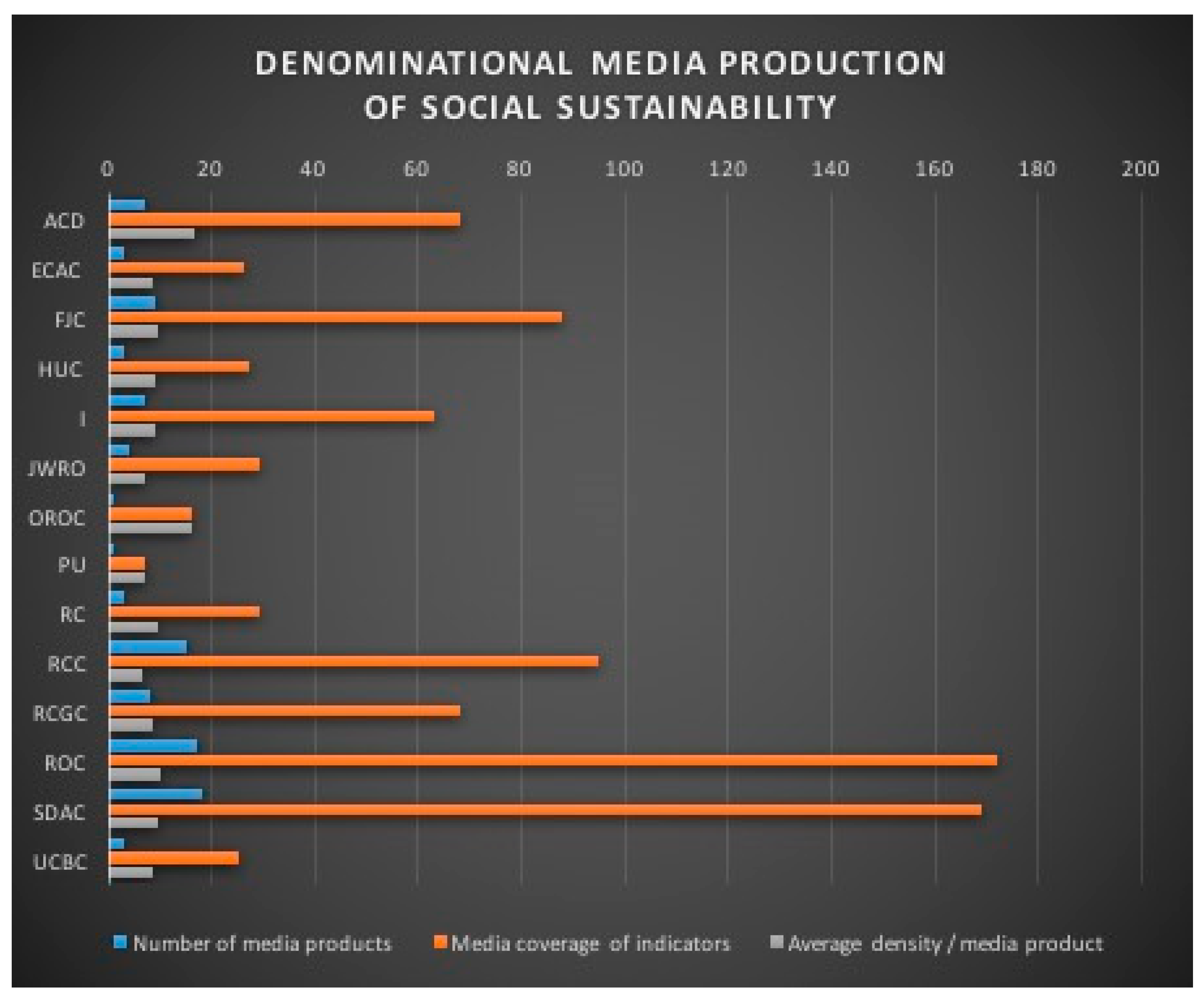
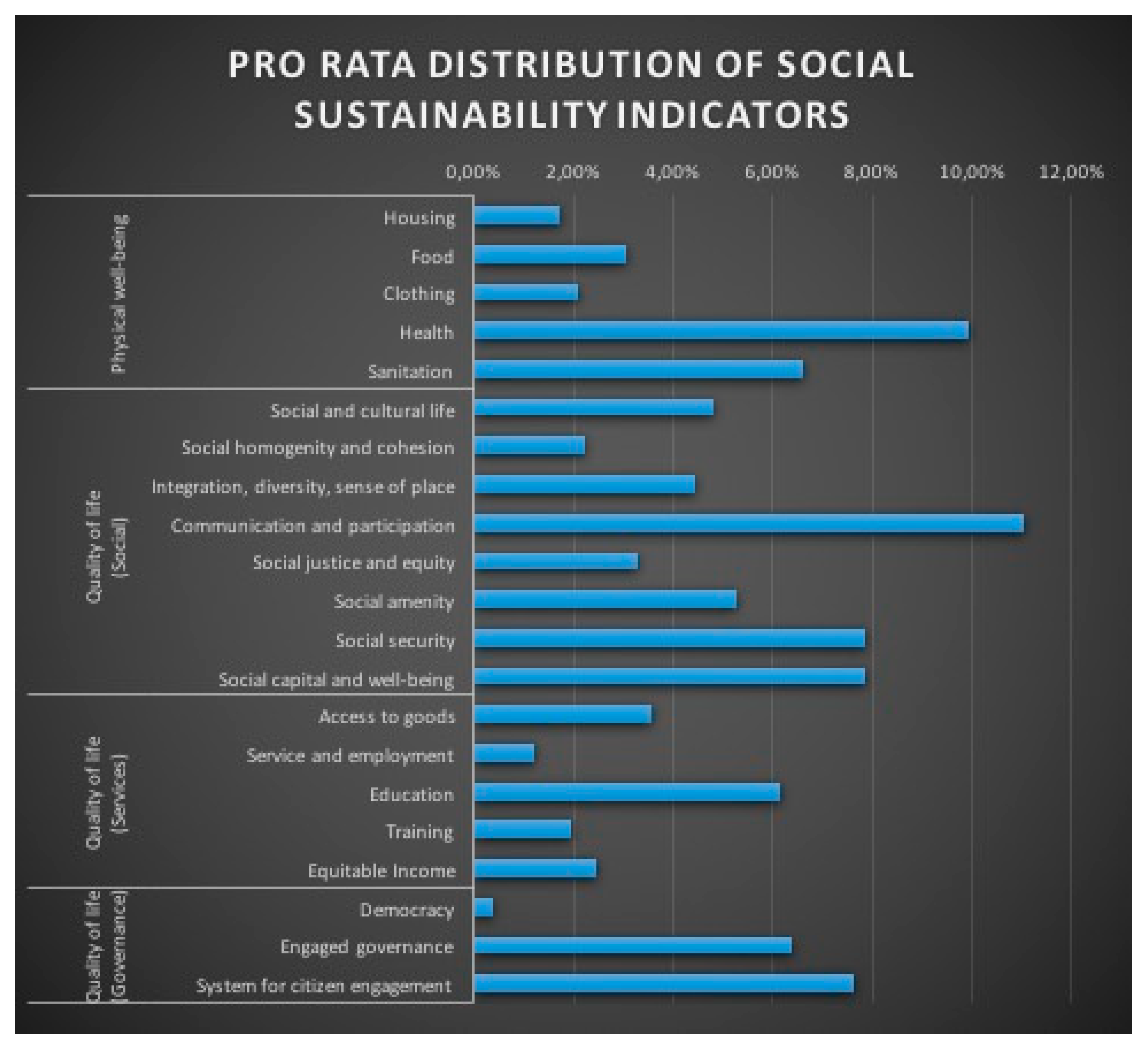
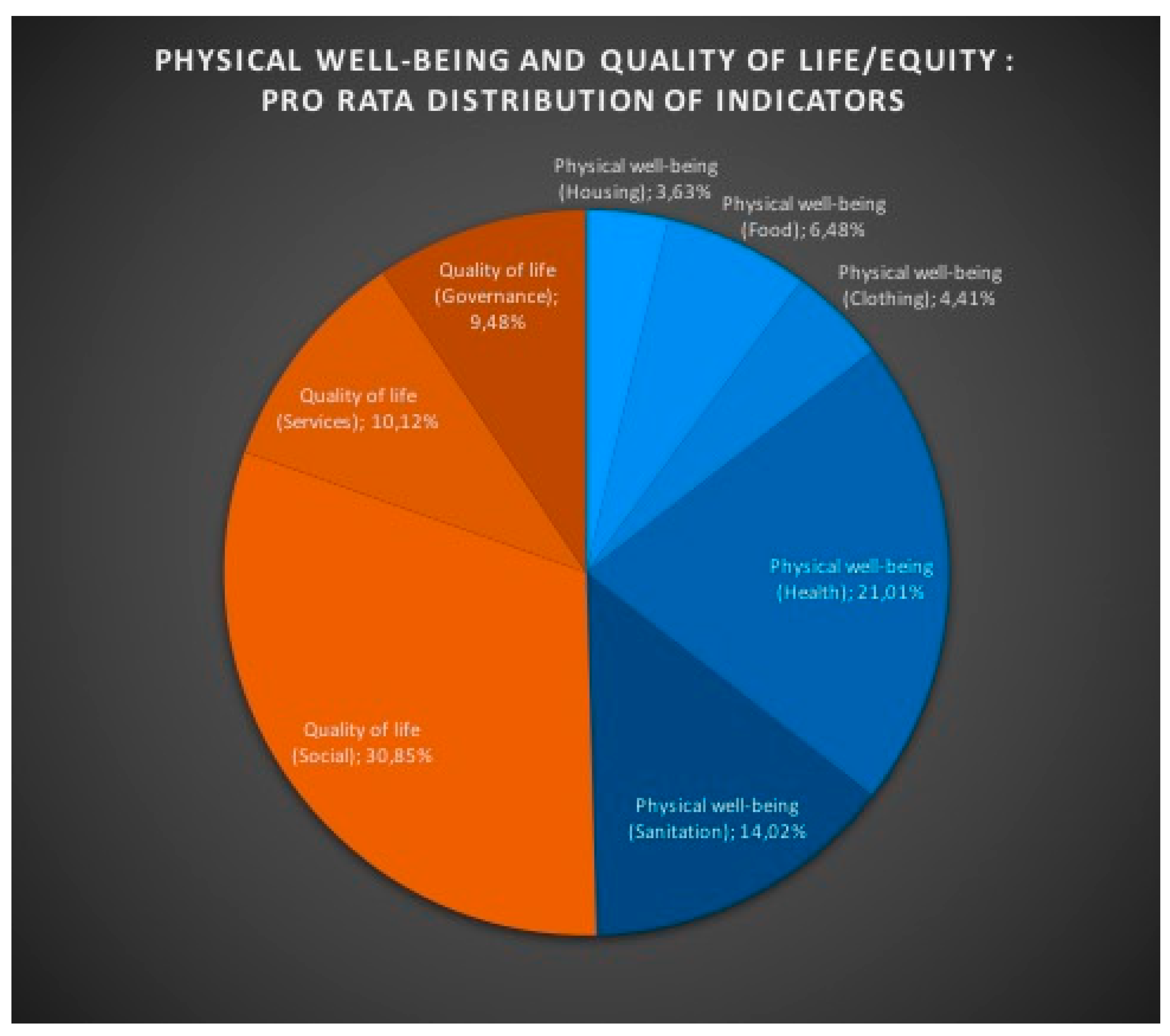
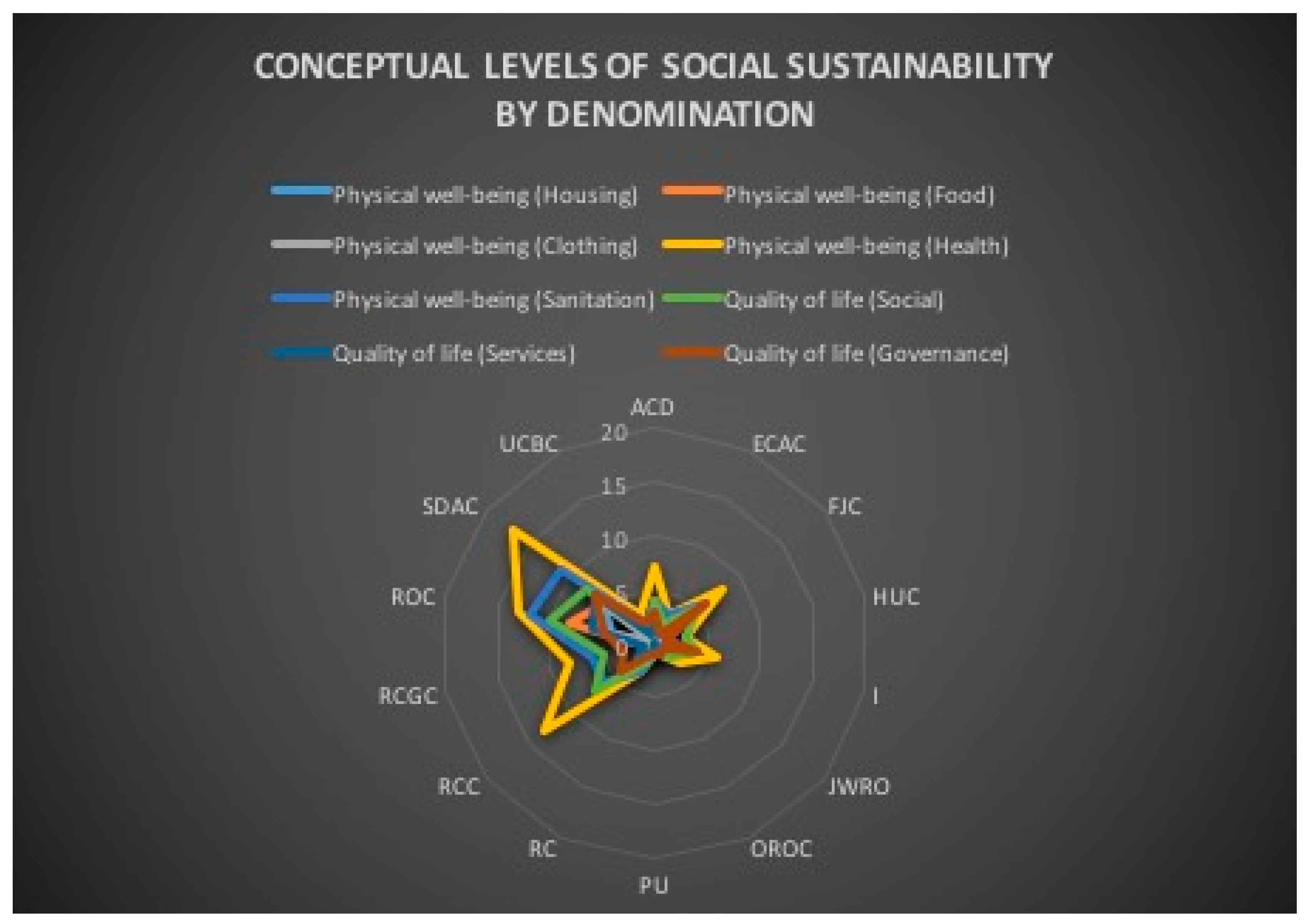
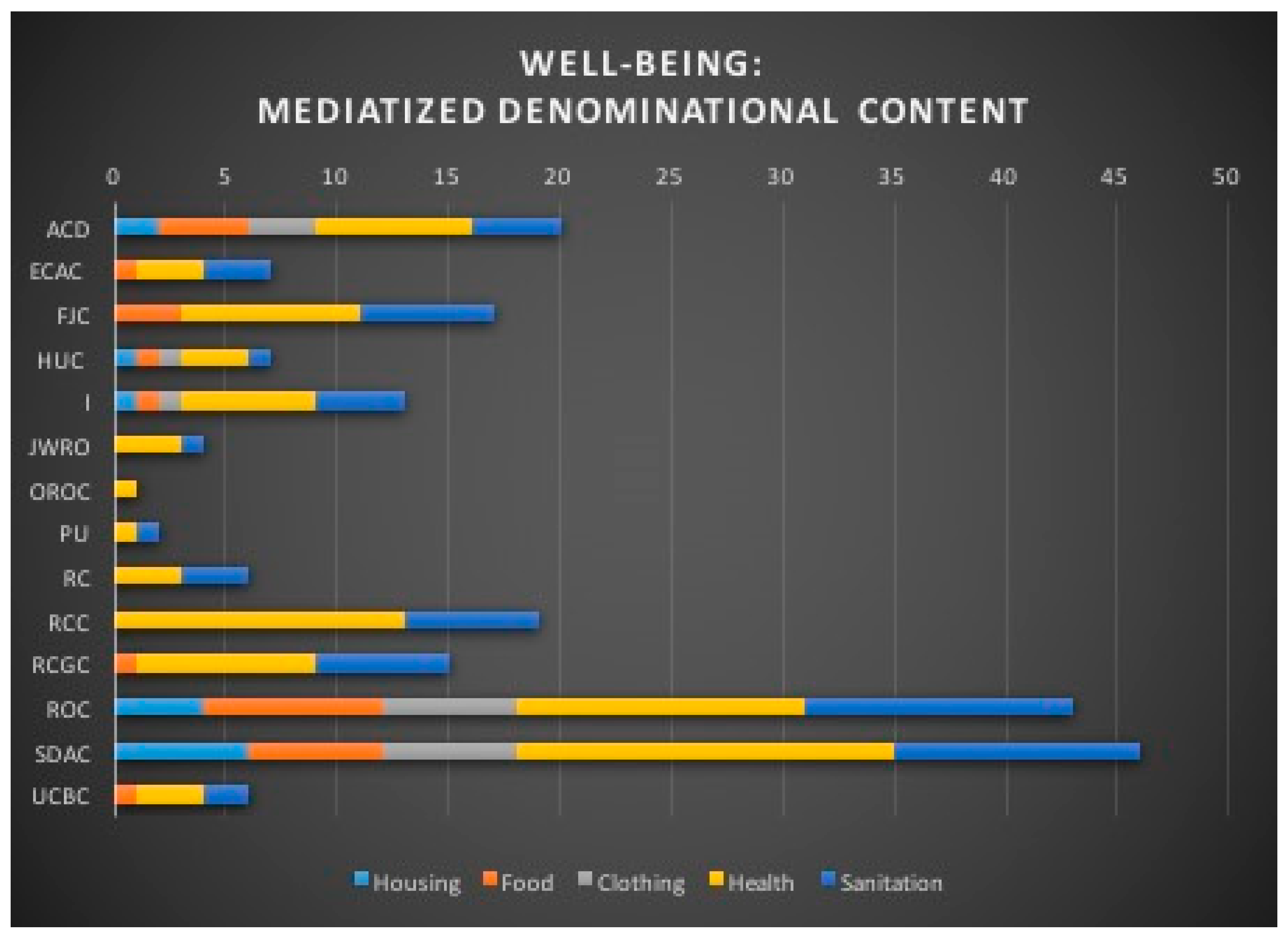
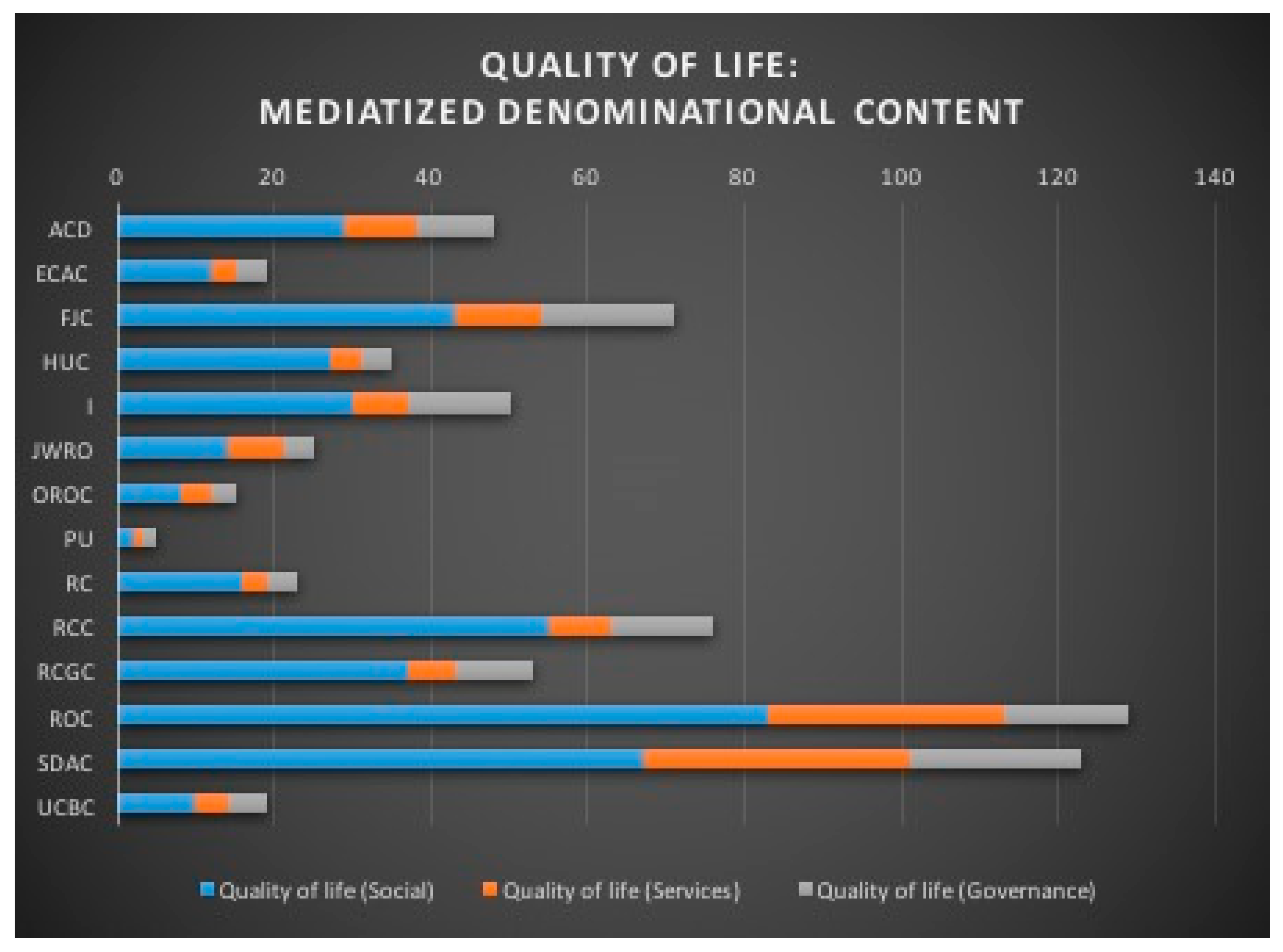
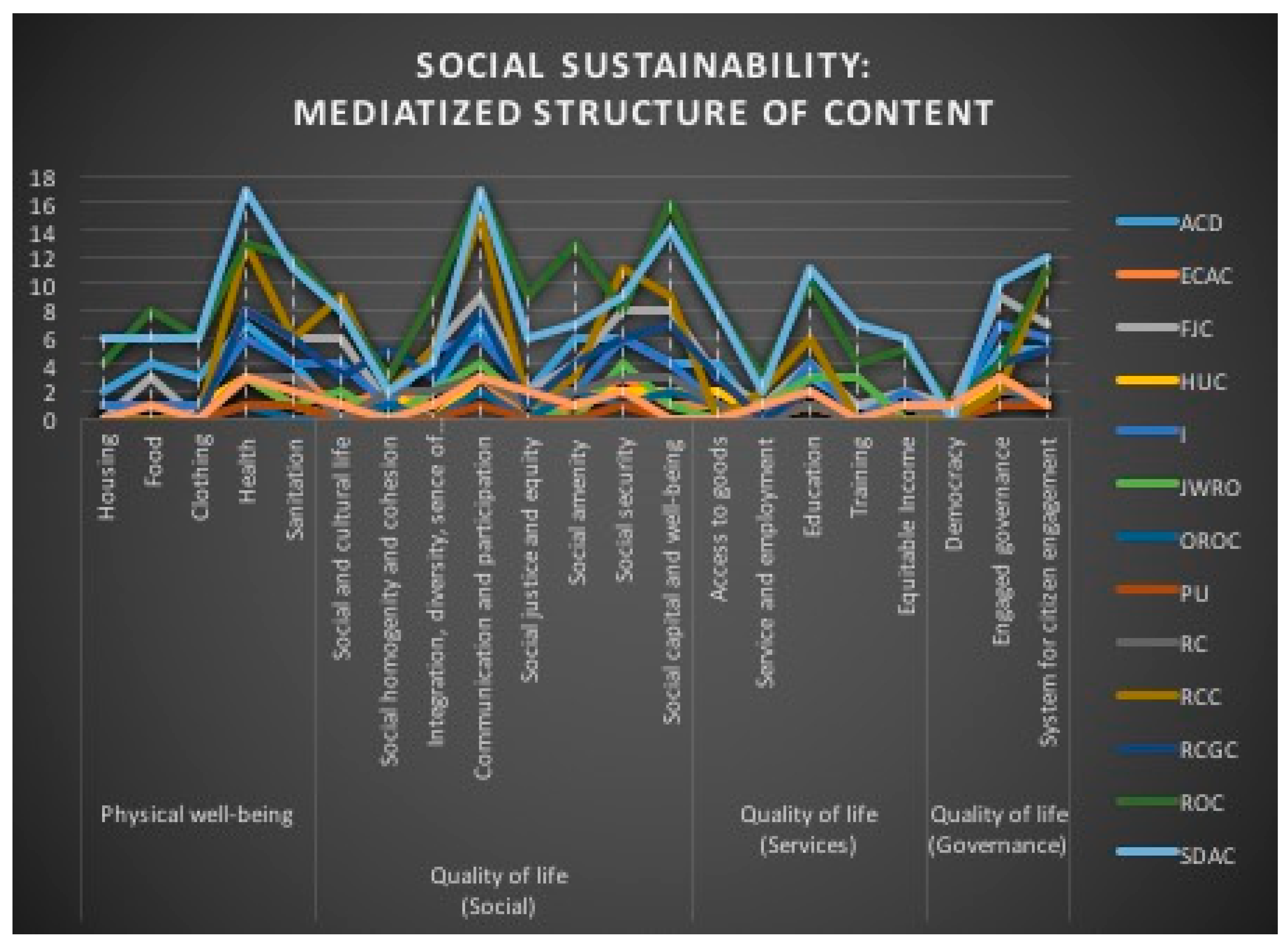
| Recognized Denominations | Acronym |
|---|---|
| Armenian Church Diocese | ACD |
| Christian Church of the Gospel in Romania | CCG |
| Evangelical Church of the Augsburg Confession of Romania | ECAC |
| Evangelical Lutheran Church of Romania | ELC |
| Federation of Jewish Communities in Romania—Jewish Faith | FJC |
| Hungarian Unitarian Church | HUC |
| Islam | I |
| Jehovah’s Witnesses Religious Organization | JWRO |
| Old-Rite Orthodox Church of Romania | OROC |
| Pentecostal Union—The Apostolic Church of God of Romania | PU |
| Reformed Church of Romania | RC |
| Roman Catholic Church | RCC |
| Romanian Church United with Rome, Greek Catholic | RCGC |
| Romanian Evangelical Church | REC |
| Romanian Orthodox Church | ROC |
| Serbian orthodox Diocese | SOD |
| Seventh-day Adventist Church in Romania | SDAC |
| Union of Christian Baptist Churches in Romania | UCBC |
| Indicators of Social Sustainability | ||
|---|---|---|
| Physical well-being | Housing | |
| Food | ||
| Clothing | ||
| Health | ||
| Sanitation | ||
| Quality of life/equity | Social | Social and cultural life |
| Social homogeneity and cohesion | ||
| Integration, diversity, sense of place | ||
| Communication and participation | ||
| Social Justice and equity | ||
| Social amenity | ||
| Social security | ||
| Social capital and well-being | ||
| Services | Access to goods | |
| Service and employment | ||
| Education | ||
| Training | ||
| Equitable Income | ||
| Governance | Democracy | |
| Engaged governance | ||
| System for citizen engagement | ||
| Denominations | Number of Media Products | Indicator Media Coverage | Average Density/ Media Product |
|---|---|---|---|
| ACD | 7 | 68 | 16.71% |
| ECAC | 3 | 26 | 8.66% |
| FJC | 9 | 88 | 9.77% |
| HUC | 3 | 27 | 9% |
| I | 7 | 63 | 9% |
| JWRO | 4 | 29 | 7.25% |
| OROC | 1 | 16 | 16% |
| PU | 1 | 7 | 7% |
| RC | 3 | 29 | 9.66% |
| RCC | 15 | 95 | 6.33% |
| RCGC | 8 | 68 | 8.5% |
| ROC | 17 | 172 | 10.11% |
| SDAC | 18 | 169 | 9.38% |
| UCBC | 3 | 25 | 8.33 |
| Indicators | % | |
|---|---|---|
| Physical well-being | Housing | 1.71% |
| Food | 3.07% | |
| Clothing | 2.08% | |
| Health | 9.95% | |
| Sanitation | 6.63% | |
| Quality of life (Social) | Social and cultural life | 4.79% |
| Social homogeneity and cohesion | 2.21% | |
| Integration, diversity, sense of place | 4.42% | |
| Communication and participation | 11.05% | |
| Social justice and equity | 3.31% | |
| Social amenity | 5.28% | |
| Social security | 7.86% | |
| Social capital and well-being | 7.86% | |
| Quality of life (Services) | Access to goods | 3.56% |
| Service and employment | 1.22% | |
| Education | 6.14% | |
| Training | 1.96% | |
| Equitable income | 2.45% | |
| Quality of life (Governance) | Democracy | 0.36% |
| Engaged governance | 6.38% | |
| System for citizen engagement | 7.61% | |
| Conceptual Levels of Social Sustainability | % |
|---|---|
| Physical well-being (Housing) | 3.63% |
| Physical well-being (Food) | 6.48% |
| Physical well-being (Clothing) | 4.41% |
| Physical well-being (Health) | 21.01% |
| Physical well-being (Sanitation) | 14.02% |
| Quality of life (Social) | 30.85% |
| Quality of life (Services) | 10.12% |
| Quality of life (Governance) | 9.48% |
| Conceptual Levels of Social Sustainability | ACD | ECAC | FJC | HUC | I | JWRO | OROC | PU | RC | RCC | RCGC | ROC | SDAC | UCBC | |
|---|---|---|---|---|---|---|---|---|---|---|---|---|---|---|---|
| Physical well-being | Housing | 2 | 0 | 0 | 1 | 1 | 0 | 0 | 0 | 0 | 0 | 0 | 4 | 6 | 0 |
| Food | 4 | 1 | 3 | 1 | 1 | 0 | 0 | 0 | 0 | 0 | 1 | 8 | 6 | 1 | |
| Clothing | 3 | 0 | 0 | 1 | 1 | 0 | 0 | 0 | 0 | 0 | 0 | 6 | 6 | 0 | |
| Health | 7 | 3 | 8 | 3 | 6 | 3 | 1 | 1 | 3 | 13 | 8 | 13 | 17 | 3 | |
| Sanitation | 4 | 3 | 6 | 1 | 4 | 1 | 0 | 1 | 3 | 6 | 6 | 12 | 11 | 2 | |
| Quality of life | Social | 4 | 2 | 5 | 3 | 4 | 2 | 1 | 0 | 2 | 7 | 5 | 10 | 8 | 1 |
| Services | 2 | 1 | 2 | 1 | 1 | 1 | 1 | 0 | 1 | 2 | 1 | 6 | 7 | 1 | |
| Governance | 3 | 1 | 6 | 1 | 4 | 1 | 1 | 1 | 1 | 4 | 3 | 5 | 7 | 2 | |
| Denominational Content | ACD | ECAC | FJC | HUC | I | JWRO | OROC | PU | RC | RCC | RCGC | ROC | SDAC | UCBC | |
|---|---|---|---|---|---|---|---|---|---|---|---|---|---|---|---|
| WELL-BEING | Housing | 2 | 0 | 0 | 1 | 1 | 0 | 0 | 0 | 0 | 0 | 0 | 4 | 6 | 0 |
| Food | 4 | 1 | 3 | 1 | 1 | 0 | 0 | 0 | 0 | 0 | 1 | 8 | 6 | 1 | |
| Clothing | 3 | 0 | 0 | 1 | 1 | 0 | 0 | 0 | 0 | 0 | 0 | 6 | 6 | 0 | |
| Health | 7 | 3 | 8 | 3 | 6 | 3 | 1 | 1 | 3 | 13 | 8 | 13 | 17 | 3 | |
| Sanitation | 4 | 3 | 6 | 1 | 4 | 1 | 0 | 1 | 3 | 6 | 6 | 12 | 11 | 2 | |
| Denominational Content | ACD | ECAC | FJC | HUC | I | JWRO | OROC | PU | RC | RCC | RCGC | ROC | SDAC | UCBC | |
|---|---|---|---|---|---|---|---|---|---|---|---|---|---|---|---|
| Quality of Life | Social | 29 | 12 | 43 | 27 | 30 | 14 | 8 | 2 | 16 | 55 | 37 | 83 | 67 | 10 |
| Services | 9 | 3 | 11 | 4 | 7 | 7 | 4 | 1 | 3 | 8 | 6 | 30 | 34 | 4 | |
| Governance | 10 | 4 | 17 | 4 | 13 | 4 | 3 | 2 | 4 | 13 | 10 | 16 | 22 | 5 | |
| INDICATORS | ACD | ECAC | FJC | HUC | I | JWRO | OROC | PU | RC | RCC | RCGC | ROC | SDAC | UCBC | |
|---|---|---|---|---|---|---|---|---|---|---|---|---|---|---|---|
| Physical well-being | Housing | 2 | 0 | 0 | 1 | 1 | 0 | 0 | 0 | 0 | 0 | 0 | 4 | 6 | 0 |
| Food | 4 | 1 | 3 | 1 | 1 | 0 | 0 | 0 | 0 | 0 | 1 | 8 | 6 | 1 | |
| Clothing | 3 | 0 | 0 | 1 | 1 | 0 | 0 | 0 | 0 | 0 | 0 | 6 | 6 | 0 | |
| Health | 7 | 3 | 8 | 3 | 6 | 3 | 1 | 1 | 3 | 13 | 8 | 13 | 17 | 3 | |
| Sanitation | 4 | 3 | 6 | 1 | 4 | 1 | 0 | 1 | 3 | 6 | 6 | 12 | 11 | 2 | |
| Quality of life (Social) | Social and cultural life | 0 | 1 | 6 | 0 | 4 | 2 | 0 | 0 | 0 | 9 | 3 | 8 | 8 | 1 |
| Social homogeneity and cohesion | 2 | 2 | 1 | 2 | 1 | 0 | 1 | 0 | 2 | 2 | 5 | 3 | 2 | 0 | |
| Integration, diversity, sense of place | 2 | 1 | 5 | 0 | 5 | 2 | 0 | 0 | 2 | 5 | 3 | 9 | 4 | 1 | |
| Communication and participation | 7 | 3 | 9 | 3 | 6 | 4 | 2 | 1 | 3 | 15 | 8 | 17 | 17 | 3 | |
| Social justice and equity | 2 | 0 | 2 | 1 | 2 | 1 | 0 | 0 | 1 | 1 | 1 | 9 | 6 | 2 | |
| Social amenity | 6 | 1 | 4 | 2 | 2 | 0 | 2 | 0 | 2 | 3 | 4 | 13 | 7 | 1 | |
| Social security | 6 | 3 | 8 | 2 | 6 | 4 | 1 | 1 | 3 | 11 | 6 | 8 | 9 | 2 | |
| Social capital and well-being | 4 | 1 | 8 | 2 | 4 | 1 | 2 | 0 | 3 | 9 | 7 | 16 | 14 | 0 | |
| Quality of life (Services) | Access to goods | 4 | 1 | 3 | 2 | 1 | 0 | 1 | 0 | 1 | 0 | 3 | 8 | 8 | 0 |
| Service and employment | 0 | 0 | 1 | 0 | 0 | 1 | 0 | 0 | 0 | 2 | 0 | 3 | 2 | 1 | |
| Education | 3 | 2 | 4 | 1 | 4 | 3 | 2 | 1 | 1 | 6 | 2 | 10 | 11 | 2 | |
| Training | 1 | 0 | 1 | 0 | 0 | 3 | 0 | 0 | 0 | 0 | 0 | 4 | 7 | 0 | |
| Equitable income | 1 | 0 | 2 | 1 | 2 | 0 | 1 | 0 | 1 | 0 | 1 | 5 | 6 | 1 | |
| Quality of life (Governance) | Democracy | 0 | 0 | 1 | 0 | 0 | 0 | 0 | 0 | 0 | 0 | 1 | 1 | 0 | 1 |
| Engaged governance | 5 | 3 | 9 | 3 | 7 | 2 | 1 | 1 | 2 | 2 | 4 | 4 | 10 | 3 | |
| System for citizen engagement | 5 | 1 | 7 | 1 | 6 | 2 | 2 | 1 | 2 | 11 | 5 | 11 | 12 | 1 | |
Publisher’s Note: MDPI stays neutral with regard to jurisdictional claims in published maps and institutional affiliations. |
© 2021 by the authors. Licensee MDPI, Basel, Switzerland. This article is an open access article distributed under the terms and conditions of the Creative Commons Attribution (CC BY) license (http://creativecommons.org/licenses/by/4.0/).
Share and Cite
Tudor, M.A.; Filimon Benea, A.; Bratosin, S. COVID-19 Pandemic Lockdown and Religious Mediatization of Social Sustainability. A Case Study of Romania. Int. J. Environ. Res. Public Health 2021, 18, 2287. https://doi.org/10.3390/ijerph18052287
Tudor MA, Filimon Benea A, Bratosin S. COVID-19 Pandemic Lockdown and Religious Mediatization of Social Sustainability. A Case Study of Romania. International Journal of Environmental Research and Public Health. 2021; 18(5):2287. https://doi.org/10.3390/ijerph18052287
Chicago/Turabian StyleTudor, Mihaela Alexandra, Anamaria Filimon Benea, and Stefan Bratosin. 2021. "COVID-19 Pandemic Lockdown and Religious Mediatization of Social Sustainability. A Case Study of Romania" International Journal of Environmental Research and Public Health 18, no. 5: 2287. https://doi.org/10.3390/ijerph18052287
APA StyleTudor, M. A., Filimon Benea, A., & Bratosin, S. (2021). COVID-19 Pandemic Lockdown and Religious Mediatization of Social Sustainability. A Case Study of Romania. International Journal of Environmental Research and Public Health, 18(5), 2287. https://doi.org/10.3390/ijerph18052287








